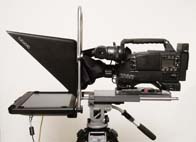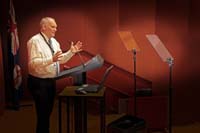Frequently Asked Questions
How Does an Autocue/Prompter System Work?
Answer:
There are three components to our hire service of an autocue/prompting system:
• The camera or conference equipment,
• The computer system & software, and
• The operator.
Suzy Cue uses laptop computers running the broadcast quality Cueword prompting software. This is specialised software which functions a bit like a word processor, and scripts can be loaded from Microsoft Word documents either emailed or from USB memory sticks, or even typed in and easily edited when required. The Cueword controller sends out a vision signal so that the script appears on a video monitor in a large sized font. The picture on the monitor is usually reversed, which allows it to be reflected onto semi-reflective glass (which are one way mirrors). This software allows the script to be smoothly scrolled up the screen, similar to the end credits of a movie. The operator controls the speed at which the text moves, keeping it in time with the presenter and stopping the text if they need to pause or adlib.
Television For television, the mirror is placed in front of the camera lens, allowing the presenter to read their script whilst appearing to look directly at the lens. This system has been the mainstay for TV news readers for decades. Because the glass only reflects on one side, the camera is not affected. |
 |
Conferences or On-Stage Events For conferences, two monitors are used which sit on the floor with the screen facing upwards. The mirrors are attached to poles, allowing them to be raised up to the height of the presenter's vision. Commonly, these Flatscreen Conference Displays will be placed one on each side of the lectern. This system allows the speaker to view their script whilst looking directly at the audience, and allows for them to scan across left and right, maintaining frequent eye contact. |
 |
Other Uses
Finally, monitors can also be used without mirrors and reversed text. Interviews, comedy and drama use monitors placed out of frame but at the appropriate eye levels, allowing scripts to be viewed, without it being apparent to an audience. Awards nights, conferences and concerts also use monitors without glass. Large monitors can be placed at the back of a venue, in the middle of the audience, or at the base of the stage, allowing scripts, speeches and song lyrics to be viewed easily.





